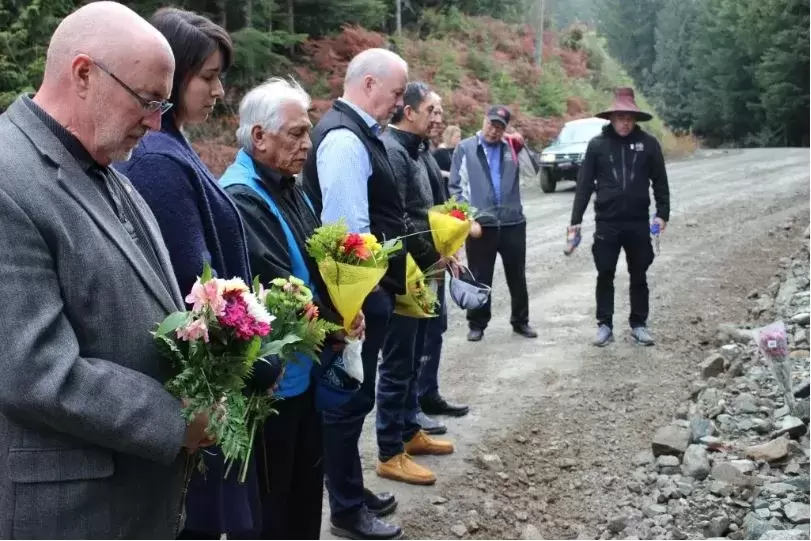Discussions are continuing to upgrade the rugged logging road that serves as the only land access to Bamfield and Anacla, with an approximate price tag of $30 million set by the provincial government.
Since Premier John Horgan visited the two communities and the site of a fatal bus crash in November government officials, forestry companies and the Huu-ay-aht First Nations have met several times to determine how to improve the 80-kilometre road that winds from Port Alberni to Bamfield. The plan is to chip seal the gravel and dirt road, a process of solidifying the surface through a combination of asphalt and fine aggregate. Building up portions of the road to mitigate winding turns is also being discussed for the upgrade, a project currently estimated at approximately $30 million.
“We’re hoping that the premier lives up to his commitment to upgrade the road,” said Robert Dennis Sr., chief councillor of the Huu-ay-aht First Nations.
“Both sides have agreed that this can be done,” he added. “From that perspective I’m feeling cautiously optimistic that potentially we may see reconciliation in action.”
For decades the Huu-ay-aht and Bamfield representatives have lobbied the provincial government to improve the road, which sees an average of 340 vehicles a day, according to the First Nation and the B.C. Ministry of Forests, Lands and Natural Resource Operations. Back in 2008 a report from Roger Harris, the province’s forest safety ombudsman, warned about the public regularly using a road that was originally intended for industrial use. Since Bamfield Main opened in the 1970s, the Huu-ay-aht have lost eight members on the road, including Tayii Haw̓ił Art Peters.
But the issue finally got the premier’s attention last fall, when a bus with 45 first-year University of Victoria students and two teachers assistants crashed halfway down the road, killing Emma MacIntosh Machado and John Geerdes, who were both 18. The group was on an annual weekend trip to the Bamfield Marine Sciences Centre, and for another trip to the centre the following month UVic avoided the road, instead sending students down the Alberni Inlet on the MV Frances Barkley.
“I think we’ve gone long enough without any proper infrastructure in our area,” said Dennis. “All I can do is cross my fingers and hope that the premier is feeling the same way. To me, by him designing this process he was doing his best to try to get to a place where we can achieve real reconciliation.”
“The meetings to date have been productive,” stated the Ministry of Transportation and Infrastructure in an email to Ha-Shilth-Sa. “However, no final decisions on road improvements have been made.”
Over the last few months the chief councillor has seen a notable improvement in the government’s response to concerns to upgrade the road.
“In the past we were always brushed off even before we got into the meeting,” he said. “I remember when Gerard Janssen was our MLA, he was the one who told me, ‘Robert, never in your lifetime will you see this road paved’. At least we get into a meeting right now.”
In the past the province has cited the road’s multiple owners as an obstacle to major upgrades, but now Mosaic and Western Forest Products have both submitted letters to the Office of the Premier formally supporting the project, said Dennis.
“At this time the companies wanted both off-road and highway vehicles to be able to use that road,” he said.
Information released by the RCMP in December indicates that the Sept. 13 crash occurred at a section where the road narrowed to 9.2 metres. Based on data from an electronic control module in the bus and physical evidence from the crash site, the accident occurred at 7:55 p.m., 44.3 kilometres from the Marine Sciences Centre. At an average speed of 37 kilometres an hour, the bus had just rounded a right-hand bend when lights from a jeep coming down a hill were visible ahead. The two vehicles passed where the road narrowed, and the bus’s right wheel crossed over the edge, causing it to fall down an embankment and flip.
Over the last month, heavy rain has significantly worsened the condition of the road, but those who regularly use Bamfield Main usually take precautions in the winter, said Dennis.
“Keep a closer eye on places where the road can erode more than other places, try as hard as you can to stay away from the edges when you’re driving,” he said. “When you get a lot of rain the shoulder can get soft and cause the road to give if there’s too much weight on it.”
“When one of us is on the road, we let someone know, and then when get to our destination we inform the people that we’re arrived safely,” added Dennis. “I think most of us have that practice.”







